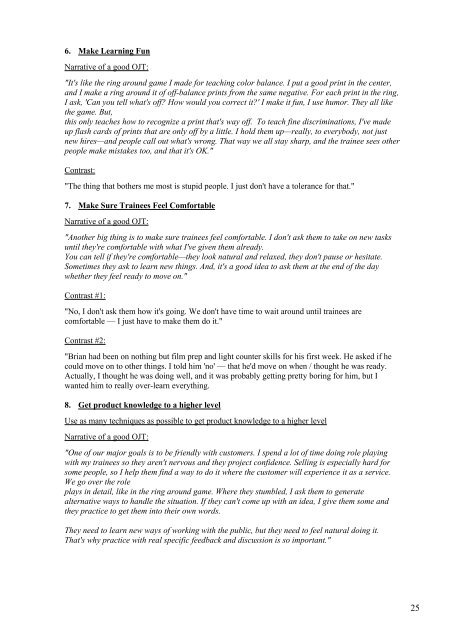How to Perform On-the-job Training - Dean Amory
According to The Encyclopedia of Business, ©2000 Gale Cengage, On-the-job training is by far the predominant form of job training. Studies also indicate that it is the most effective form of job training. Yet, it also represents a significant investment considering that roughly 30% of a new worker's time is spent in on-the-job training during the first 90 days of employment, that productivity of experienced workers assigned to train new workers may decrease during the training period, and that new workers may make expensive mistakes. Both companies and workers therefore profit largely from the presence of simple, but complete trainee and trainer guides that allow for executing OJT in a structured way. “How to perform on-the-job training”, has the information, techniques and tips that will allow you to implement a professional OJT training program. The book also includes all the tools, documents and checklists necessary for setting up a qualitative and efficient skills training program for OJT coaches
According to The Encyclopedia of Business, ©2000 Gale Cengage, On-the-job training is by far the predominant form of job training. Studies also indicate that it is the most effective form of job training. Yet, it also represents a significant investment considering that roughly 30% of a new worker's time is spent in on-the-job training during the first 90 days of employment, that productivity of experienced workers assigned to train new workers may decrease during the training period, and that new workers may make expensive mistakes.
Both companies and workers therefore profit largely from the presence of simple, but complete trainee and trainer guides that allow for executing OJT in a structured way.
“How to perform on-the-job training”, has the information, techniques and tips that will allow you to implement a professional OJT training program. The book also includes all the tools, documents and checklists necessary for setting up a qualitative and efficient skills training program for OJT coaches
You also want an ePaper? Increase the reach of your titles
YUMPU automatically turns print PDFs into web optimized ePapers that Google loves.
6. Make Learning Fun<br />
Narrative of a good OJT:<br />
"It's like <strong>the</strong> ring around game I made for teaching color balance. I put a good print in <strong>the</strong> center,<br />
and I make a ring around it of off-balance prints from <strong>the</strong> same negative. For each print in <strong>the</strong> ring,<br />
I ask, 'Can you tell what's off? <strong>How</strong> would you correct it?' I make it fun, I use humor. They all like<br />
<strong>the</strong> game. But,<br />
this only teaches how <strong>to</strong> recognize a print that's way off. To teach fine discriminations, I've made<br />
up flash cards of prints that are only off by a little. I hold <strong>the</strong>m up—really, <strong>to</strong> everybody, not just<br />
new hires—and people call out what's wrong. That way we all stay sharp, and <strong>the</strong> trainee sees o<strong>the</strong>r<br />
people make mistakes <strong>to</strong>o, and that it's OK."<br />
Contrast:<br />
"The thing that bo<strong>the</strong>rs me most is stupid people. I just don't have a <strong>to</strong>lerance for that."<br />
7. Make Sure Trainees Feel Comfortable<br />
Narrative of a good OJT:<br />
"Ano<strong>the</strong>r big thing is <strong>to</strong> make sure trainees feel comfortable. I don't ask <strong>the</strong>m <strong>to</strong> take on new tasks<br />
until <strong>the</strong>y're comfortable with what I've given <strong>the</strong>m already.<br />
You can tell if <strong>the</strong>y're comfortable—<strong>the</strong>y look natural and relaxed, <strong>the</strong>y don't pause or hesitate.<br />
Sometimes <strong>the</strong>y ask <strong>to</strong> learn new things. And, it's a good idea <strong>to</strong> ask <strong>the</strong>m at <strong>the</strong> end of <strong>the</strong> day<br />
whe<strong>the</strong>r <strong>the</strong>y feel ready <strong>to</strong> move on."<br />
Contrast #1:<br />
"No, I don't ask <strong>the</strong>m how it's going. We don't have time <strong>to</strong> wait around until trainees are<br />
comfortable — I just have <strong>to</strong> make <strong>the</strong>m do it."<br />
Contrast #2:<br />
"Brian had been on nothing but film prep and light counter skills for his first week. He asked if he<br />
could move on <strong>to</strong> o<strong>the</strong>r things. I <strong>to</strong>ld him 'no' — that he'd move on when / thought he was ready.<br />
Actually, I thought he was doing well, and it was probably getting pretty boring for him, but I<br />
wanted him <strong>to</strong> really over-learn everything.<br />
8. Get product knowledge <strong>to</strong> a higher level<br />
Use as many techniques as possible <strong>to</strong> get product knowledge <strong>to</strong> a higher level<br />
Narrative of a good OJT:<br />
"<strong>On</strong>e of our major goals is <strong>to</strong> be friendly with cus<strong>to</strong>mers. I spend a lot of time doing role playing<br />
with my trainees so <strong>the</strong>y aren't nervous and <strong>the</strong>y project confidence. Selling is especially hard for<br />
some people, so I help <strong>the</strong>m find a way <strong>to</strong> do it where <strong>the</strong> cus<strong>to</strong>mer will experience it as a service.<br />
We go over <strong>the</strong> role<br />
plays in detail, like in <strong>the</strong> ring around game. Where <strong>the</strong>y stumbled, I ask <strong>the</strong>m <strong>to</strong> generate<br />
alternative ways <strong>to</strong> handle <strong>the</strong> situation. If <strong>the</strong>y can't come up with an idea, I give <strong>the</strong>m some and<br />
<strong>the</strong>y practice <strong>to</strong> get <strong>the</strong>m in<strong>to</strong> <strong>the</strong>ir own words.<br />
They need <strong>to</strong> learn new ways of working with <strong>the</strong> public, but <strong>the</strong>y need <strong>to</strong> feel natural doing it.<br />
That's why practice with real specific feedback and discussion is so important."<br />
25


















